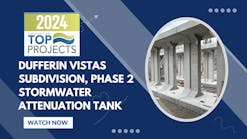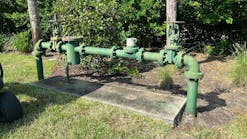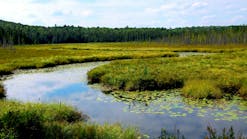Managing Stormwater in Charlotte, North Carolina: An Innovative Approach
The City of Charlotte, located in Mecklenburg County, NC, has developed an aggressive stormwater and water-quality program to address its aging stormwater infrastructure and the growing demands associated with rapid growth and development. Similar to so many other metropolitan areas, the City of Charlotte and Mecklenburg County (Charlotte-Mecklenburg) are working hard to balance the aging systems, the growing population, and the resources affected by these. A primary challenge is to manage issues proactively and implement initiatives with limited resources and time. Charlotte-Mecklenburg continually strives to find innovative and cost-effective ways to address the many issues that confront the programs and has undertaken numerous initiatives to help maintain, improve, and restore streams and stormwater channels in a dynamic environment.
The Charlotte metropolitan area is located in the southern Piedmont region of North Carolina. Unlike many older metropolitan areas, the majority of Charlotte-Mecklenburg’s drainage infrastructure remains as open channel. Approximately 2,400 mi. of pipes, ditches, and channels traverse the 234-mi.2 city; of this, approximately 2,100 mi. are represented by open stream flow. The area’s rolling topography and relatively dense clay soils, combined with widespread urban development, make stormwater problems commonplace. All the streams within Charlotte-Mecklenburg originate there, however, giving the city and county full charge of the solutions and full responsibility for the problems.
Given watersheds uninfluenced by political neighbors, Charlotte-Mecklenburg began managing its surface-water resources in the 1970s through the Mecklenburg County Department of Environmental Protection (MCDEP). MCDEP’s initial role was to monitor stream quality, educate, and enforce state regulations and local policy. The majority of Charlotte-Mecklenburg’s streams, ditches, pipes, and other drainage infrastructure are located on private property and received little, if any, maintenance. Maintenance of the infrastructure was traditionally the responsibility of the property owner, with the exception of pipes and culverts located in public street right of ways, which were maintained by the city’s engineering and transportation departments. Nevertheless, the system was not maintained as a complete system.
In December 1992, a new, comprehensive stormwater program was created to proactively manage Charlotte-Mecklenburg’s stormwater runoff. The program, called Charlotte-Mecklenburg Storm Water Services (CMSWS), is a multifaceted, fee-based enterprise, evolving as technology advances, regulations change, and the community grows. The stormwater program was the first of its kind in North Carolina and was created to carry out all aspects of the stormwater program through in-house activities and contracts with other government agencies and private-sector businesses. Much support for the program is obtained through combining resources with Charlotte-Mecklenburg’s Economic Development Program, Neighborhood Improvement Program, Erosion Control Program, Land Development Division, Solid Waste Special Services Division, Street Maintenance Division, Utility Department, Environmental Protection Department, and Parks and Recreation Department. The formation of this program was in large part jump-started by the federally mandated Phase I municipal stormwater National Pollutant Discharge Elimination System (NPDES) permitting requirements.
The demand for services from the new program was intense immediately. The network of pipes, culverts, and ditches in Charlotte-Mecklenburg was constructed as the area developed over the last century. This system, along with a system of mostly channelized streams, had deteriorated with age and the increasing demands of urbanization. In addition, the NPDES permit required complete inventory and monitoring of the drainage system, as well as the immediate implementation of a water-quality management plan.
The stormwater program was organized to efficiently address these demands while delivering the highest possible customer service to the community. Charlotte-Mecklenburg has undertaken numerous activities to achieve goals for proactively managing its stormwater and surface-water systems. The intention of these goals is to catch up with the large backlog of repairs, maintenance, and improvements to the drainage infrastructure needed after decades of inaction; to prevent the loss of life or property to flooding; to begin planning for optimal use of the infrastructure rather than the reactionary mode of the past; to protect against pollution by preserving and enhancing the quality of the community’s surface waters; to preserve and enhance the natural and beneficial functions of the floodplain; and to educate, involve, and satisfy Charlotte-Mecklenburg’s citizens.
Capital improvements are made to the drainage infrastructure and natural streams through three main program areas: flood control, maintenance, and channel improvements. This format allows areas with widespread problems to be more thoroughly planned and allows localized problems that most likely will not affect other parts of the system to be addressed more quickly and for less cost. Each program area heavily integrates public involvement into the planning, design, and construction of the projects.
A flood-control project is a large-scale project encompassing drainage issues throughout a neighborhood, including upgrades to culverts, pipes, and channels. These projects are often coordinated with the Neighborhood Improvement Program in areas where drainage improvements can be made in support of larger neighborhood reinvestment projects. Planning, design, and construction of a flood-control project typically takes five years. To date, more than 30 large flood-control projects have been completed on the minor system.
To prevent or reduce the loss of life, disruption of services, and damages caused by floods along the major system, Charlotte-Mecklenburg developed a floodplain land acquisition (“buyout”) program. Currently, 118 flood-prone homes in six Charlotte neighborhoods have been purchased through a $14.4 million acquisition program. Federal and state sources account for 65% of program funding. The majority of the funding was provided through the Federal Emergency Management Agency (FEMA) Hazard Mitigation Grant Program. Most of the eligible houses were built prior to the first floodplain regulations and greatly overstep what is permitted today. The current buyout program is directed toward removing houses in the floodway, the most dangerous part of the floodplain. The acquired properties will be demolished to ensure they do not flood again. The resulting open space will be used to support other community values, such as the extension of the greenway system and improved water quality.
Maintenance projects are small-scale repairs involving one to four properties and may focus on a single culvert, channel segment, or customer service complaint. The objective of these projects is to identify and repair failing infrastructure before safety or property is endangered. To date, more than 1,600 small repair projects have been completed on the minor system. An extension of the maintenance-type project is the channel project. A channel project restores eroded or blocked channels. Service requests in this area seem to be steady, with about 500 requests received annually. More than 200 projects have been completed on the major and minor systems.
Charlotte-Mecklenburg also coordinates its stormwater maintenance and improvement activities with the Economic Development Program, which promotes infill development. Recently, infrastructure maintenance and improvement took on the task of restoring stormwater-quality benefits of select existing ponds and lakes throughout Charlotte-Mecklenburg through the Pond and Dam Restoration Policy (pond policy).
The pond policy was developed for servicing existing ponds and dams located on the minor system that provide for stormwater pollution control, flood control, or safety benefits to the community. The pond policy contains qualifying criteria by which it is determined when it is in the public’s best interest for the city to make improvements to a privately owned pond. In general, proper maintenance of the dam and pool of privately owned wet ponds continues to be the responsibility of the private owner. In the future, it is anticipated that the pond policy will be used with master planning techniques to identify existing wet ponds located in areas needing stormwater pollution improvement.
Stormwater maintenance and flood-control projects by nature require disturbance of the stream channel and often require enlarging pipes and channels and using hard, invasive techniques. Charlotte-Mecklenburg has developed an evolving process to ensure maintenance work and capital improvements meet federal, state, and local requirements with regard to water quality and disturbance of streams and channels. The Phase I NPDES permit requirements and the need for compensatory mitigation of potentially negative ecological impacts of the projects have encouraged the use of alternative solutions, such as soil bioengineering and stream restoration/natural channel design where possible. For the past six years, Charlotte-Mecklenburg has employed mandatory open-channel stabilization using bioengineering techniques for all open channels and perennial streams in need of stabilization or modification. The use of vegetation has also been expanded in detail for use in design and/or improvement of best management practices (BMPs), such as stormwater wetlands and wet ponds. Various streamside observation stations have been established where species of vegetation are “tested” for their hardiness in this region and ability to stabilize streambanks in a variety of conditions, including sun exposure and slope. City and county staff produced a variety of technical standards for use in current construction and future development.
Charlotte-Mecklenburg initiated a regionally significant stream morphology research program through the University of North Carolina at Charlotte. The program is establishing statewide criteria for urban natural channel design. The research has produced regional curve data for the morphological characteristics of urban streams, including return intervals for the morphological “bankfull” and associated urban channel characteristics.
The use of nontraditional engineering methods has had several challenges for the program and has also opened many doors. Some of the challenges have included maintenance of vegetated urban channels; educating staff, consultants, and property owners; and the constraints of the urban setting. The last of these challenges is not easily overcome and pretty much makes or breaks the project’s ability to be designed with “soft” techniques. The proximity of homes, sanitary sewer lines, and roads, to name a few, impede the ability to “unchannelize” a creek with natural meanders. The success of incorporating these more natural channel designs into the stormwater program requires personnel to think outside the box and stop to ask, “Do I have to use riprap? Is pipe really needed? Is there another way or a combination of ways that might take a little more effort initially but will pay off in the long term?” If channels are designed to carry storm flow as they more naturally would, given a watershed with “built-out” conditions, then they will more or less self-maintain and ideally improve quality of habitat as well as the water being sent downstream. Charlotte-Mecklenburg promotes the use of water-quality BMPs and vegetative and other natural channel restoration remedies when and where appropriate on capital and maintenance projects to enhance surface water quality in the local drainage basin.
The stormwater program is moving toward integrating a holistic watershed approach—the merger of flood control and water-quality improvement, including stream restoration and enhancement. Charlotte-Mecklenburg’s commitment to this approach is reflected in ongoing efforts to set up an internal mitigation bank that will be available to other public projects. The Edward’s Branch Watershed Improvement Project demonstrates the holistic watershed approach (see sidebar) and has been proposed as the first “deposit” into the mitigation bank.
The major goals of infrastructure repair and improvement activities are to eliminate the backlog of service requests and implement a balanced portfolio where stormwater infrastructure is managed with respect to the “big picture.” In other words, stormwater improvements are made in consideration of other neighborhood improvements and needs, economic development goals, and watershedwide stormwater quantity and quality problems.
Water quality is also a prominent aspect of Charlotte-Mecklenburg’s stormwater management. Activities involve measures to comply with EPA nonpoint-source pollution regulations and state water-supply watershed protection regulations, master planning, public education, water sampling and testing, industrial inspection and monitoring, and elimination of illegal water-pollution activities. The City of Charlotte has operated under a municipal separate storm sewer system NPDES permit since November 1, 1993. The permit is administered in cooperation with other city and county departments through the Storm Water Quality Management Program (SWQMP). The overall objectives of the SWQMP are consistent with the federal stormwater permitting regulations, the expectations of the State of North Carolina, and local water-quality initiatives. The SWQMP concentrates on five major categories of stormwater management including commercial and residential activities, illicit connection and improper disposal, industrial and related facilities, construction sites, and public education/involvement. This program structure is more compatible with the NPDES Phase II requirements and will therefore facilitate cooperation and information sharing.
Specific activities to be completed within each major category are planned annually. Unknown to many, the SWQMP (i.e., the permit) actually includes many activities that have dual functions in stormwater management and at first glance might not be considered by some to be water-quality related, such as infrastructure inventory, maintenance, and inspection. Several highlights of the SWQMP are stream monitoring, pollution response, stormwater-quality BMP pilot projects, and the cooperative interagency relationships that have developed.
To gather water-quality data, a comprehensive stream-monitoring plan includes ambient (“dry weather”) and in-stream stormwater (“wet weather”) monitoring of chemical, physical, and biological parameters. Ambient monitoring activities provide an effective tool for problem-area field screening, and in-stream stormwater monitoring is performed at six sites quarterly to measure in-stream pollutant loads. Biological monitoring helps assess the long-term effectiveness of the stormwater program activities. Land-use—related pollutant loads were evaluated through stormwater-quality data collected by the US Geological Survey from 1994 through 1998. A locally developed Water Quality Rating System is used to determine the general water-quality conditions in Charlotte-Mecklenburg. The system incorporates chemical, physical, and biological parameters and is based on the merger of two indices (a modification of the water-quality index NSF International Inc. developed for physical and chemical parameters and a biotic index developed from benthic macroinvertebrate sampling data).
The program addresses potential pollution problems through evaluation of ambient stream-monitoring results and through public reporting. As a result of an extensive public-awareness campaign, public reporting of water-quality issues has been as high as 615 requests or complaints annually.
A major component of the SWQMP is planning for structural and nonstructural stormwater BMPs in new development and for regional stormwater controls where possible and appropriate. Currently, stormwater-quality BMPs are required for new development in the drinking-water supply watershed protection areas and through the new Charlotte-Mecklenburg stream buffer regulations. Controls have also been used voluntarily or in response to violations of the city’s stormwater pollution ordinance. The stormwater utility fee credit system encourages the installation of wet ponds and extended detention ponds in new and existing developments; the monthly service fee is reduced in exchange for maintaining a system that removes or reduces the effect of stormwater runoff from the impervious area. In addition, Charlotte-Mecklenburg initiates the use of stormwater-quality controls through the pond policy, floodplain buyout program, and implementation of several “pilot” BMP projects.
The BMP pilot projects have resulted in the installation and testing of a Stormceptor device in the parking lot of a commercial development and in the drainage system of the Charlotte-Mecklenburg bus-transit maintenance center; the design, construction, and testing of a multiuser truck-rinsing and clean-out facility at the city’s central operations yard; and the design of several other projects that will be installed and monitored in the near future, such as the Edward’s Branch Watershed Improvement Project.
Improving coordination with other agencies has been an important goal within Charlotte-Mecklenburg for managing stormwater quality. In addition to the program implementation relationship between CMSWS and MCDEP, several interagency cooperative relationships have developed between the Water Quality Coalition, the Creek Coordination Committee, and the Cooperative Technical Information Exchange (CATIE). The Water Quality Coalition is a group of local agencies involved in promoting water-quality initiatives and public education united to reduce overlap and improve efficiency. The Creek Coordination Committee is a group of local agencies with a vested interest in Charlotte-Mecklenburg’s streams and riparian corridors for the multiple functions of water quality and habitat, stormwater conveyance, utility location, and recreation. CATIE is a database system developed to assist in tracking illicit connections and identifying potential pollution sources and involves cooperation from MCDEP, CMSWS, Charlotte-Mecklenburg Utilities, and the local fire department. Because of its longstanding role in the local protection of water quality and extensive stream monitoring, MCDEP works closely with CMSWS in carrying out the SWQMP.
A significant coordinated effort has been made through a plan called the Surface Water Improvement and Management (SWIM) Initiative. SWIM is designed to restore the quality and usability of Charlotte-Mecklenburg surface waters so they are suitable for human body contact and recreational opportunities and are supportive of a wide variety of aquatic animals and plants. SWIM gained full momentum in October 1996 when the Board of County Commissioners (BOCC) issued a creek-use policy statement in support of cleaning up Mecklenburg County’s surface waters. Subsequently, a panel of community stakeholders was formed, representing government agencies, the development industry, and environmental groups, to develop alternatives and potential costs for achieving the SWIM objectives. Consensus was obtained through numerous public involvement forums within a period of less than one and a half years. The panel’s efforts culminated in the development of a phased water-quality maintenance and restoration plan. Phase I was a nine-part strategy aimed at addressing Charlotte-Mecklenburg’s two worst polluters: fecal coliform bacteria and sediment. The SWIM plan also called for implementing a countywide water-quality modeling program, enhancing current water-quality monitoring efforts, improving coordination between agencies, increasing public education, and establishing a countywide buffer system for streams. In April 1998, Phase I of the plan received unanimous support from the BOCC, and full funding was approved effective July 1, 1998. Implementation of the SWIM plan has progressed very well and complements the mandate-driven SWQMP.
To comply with additional federal regulations, Charlotte-Mecklenburg developed a total maximum daily load (TMDL) for fecal coliform in three of the city’s major stream basins. As part of this effort, Charlotte-Mecklenburg’s water-quality modeling capabilities were enhanced for improved water-quality management and in anticipation of additional TMDL requirements for other pollutants, such as metals and nutrients, in the future.
Overall, Charlotte-Mecklenburg’s stormwater-quality programs and initiatives emphasize the use of both structural and nonstructural BMPs in managing and maintaining the municipal stormwater infrastructure. Nonstructural BMPs include such activities as coordination, education, and public involvement. The programs also focus on proven successful activities, improving program implementation and planning, and enhancing public education efforts.
Planning and management of the stormwater infrastructure is achieved through inventory of drainage infrastructure, modeling of the system to identify problem areas and optimum solutions, and prioritizing repair and improvement projects. In the early 1990s, Charlotte-Mecklenburg initiated a process to collect stormwater infrastructure inventory in order to meet the reporting requirements of the NPDES Phase I regulations. The collection of additional information (e.g., an extensive network of rainfall gauges, stream flow measurements, stream morphology characteristics, and stream and stormwater pollutant measurements) was also initiated to aid in planning and management of the stormwater infrastructure. Since 1961, Charlotte-Mecklenburg has worked with the USGS, gathering rainfall and stream flow information through a cooperative, cost-sharing program. City and county staff, consulting engineers, and surveyors throughout the region have used these data extensively.
Since 1993 there has been a vision that watershed modeling and data management can be achieved through connecting model engines to a geographic information system (GIS). In late 1998, Charlotte-Mecklenburg began development of a comprehensive Watershed Information SystEm (WISE) that facilitates the development and maintenance of a “living” master plan of stormwater improvements throughout the city and county. WISE is a GIS-based system that integrates all pertinent information related to stormwater management and links it together for interactive watershed modeling, planning, and design. For example, such data as the existing drainage feature inventory; stream-flow gauge data; watershed parameter GIS coverages such as soil type, land use, and topography; water-quality monitoring data; and citizen requests are linked with applications such as hydrologic-hydraulic and/or water-quality models to perform what-if scenarios for proposed maintenance, capital improvements, or siting and selection of water-quality BMPs. The system is designed to keep current the hydrologic and hydraulic models for the entire county and to provide users with a full array of tools for evaluating capacity and design requirements of storm drainage systems, water-quality alternatives using BMPs, impact of zoning changes, and proposed physical modifications to the drainage infrastructure. Developing the system has been a significant endeavor that will directly benefit not only Charlotte-Mecklenburg’s stormwater program but also others involved in stormwater management and emergency response throughout Mecklenburg County. The benefit and functionality of WISE have been demonstrated through the development of updated floodplain maps.
One significant goal of the development of WISE is to reduce the overall cost of preparing stormwater and floodplain studies. It is estimated that the cost to perform hydrologic and hydraulic modeling tasks has dropped by more than 30%. In addition, WISE includes an inventory module that will facilitate the effort to update and complete the storm drainage inventory using pen-based field computers to avoid inconsistent and poor quality data.
To protect existing and future development from flooding, Charlotte-Mecklenburg used WISE to remap the floodplain of streams with a contributing drainage greater than 640 ac. Because some new buildings and flooding in certain areas are not depicted on FEMA maps, Charlotte-Mecklenburg recognized the critical need for accurate floodplain maps. In addition, there has been a realization that new development in and around floodplains must be regulated as a precaution against future flooding caused by increased flow from continued development in upstream watersheds. The new flood elevations and floodplain boundaries were developed in cooperation with the US Army Corps of Engineers and FEMA. WISE integrated FEMA-accepted computer models to simulate the effect of rainfall and subsequent runoff in each unique watershed in Charlotte-Mecklenburg. The models are then calibrated or verified by using rainfall and stream-flow gauge data and property-owner testimonials of actual storms that occurred in the past (e.g., 1995 and 1997 storms) to ensure that the models can adequately reproduce the observed events. Based on various land use conditions (present and future buildout) and floodplain development assumptions, floodplain maps were developed and used for flood insurance rating purposes (FEMA maps). Rather than the 1-ft. surcharge used on the Mecklenburg County FEMA maps developed in the 1970s, Mecklenburg County’s new floodplain maps are drawn with a 0.5-ft. surcharge value for FEMA purposes.
To protect against future flooding caused by continued development not reflected on the FEMA maps, Charlotte-Mecklenburg developed local Floodplain Land Use Maps (FLUM). The FLUM contain technical information that is more restrictive than FEMA’s (more than a 50% increase in regulated floodway) and are being used to guide new development.
Regulation and enforcement of stormwater policies are necessary to protect resources and guide development. Local stormwater and land development regulations include fee credits, sedimentation and erosion control, subdivisions, pollution control, floodplain, and drainage and detention. The highlights of these regulations include the administration of the local sedimentation and erosion control program, updates to the FEMA maps, creation of the FLUM, and a new policy concerning stream buffers.
Charlotte-Mecklenburg has operated a local erosion and sedimentation control permitting program since 1985. This program has benefited the community by providing increased inspections and enforcement and more expeditious review of land development for approval. The erosion control program also laid some of the framework for the stormwater ordinances that began in 1993 and associated stormwater infrastructure design requirements. The ordinance and design manual is updated continually with changes to better manage Charlotte-Mecklenburg’s resources.
In 1999, a stream buffer ordinance was created for conveyances with a contributing drainage equal to or greater than 100 ac. The ordinance requires a buffer to have three zones, which serve to balance land use with stream protection. The closer the zone is to the stream, the more restrictive the use requirements. The buffer also varies in width based on the size of the stream’s drainage basin. The larger the drainage basin, the wider the buffer. The drainage basin sizes and corresponding buffer widths, per zone, are summarized in Table 1.
The stream buffer system provides protection for water quality and aquatic and wildlife habitat and increased storage area for floodwaters. It significantly expands the green space area in the rapidly urbanizing community.
In addition, the Charlotte-Mecklenburg stormwater design manual was recently updated with a channel management policy, which applies to streams draining less than 100 ac. (i.e., channels upstream of the areas regulated by the SWIM stream buffer plan) and requires developers to manage stream channels using one of three methods:
1. A riparian stream buffer may be established to prevent encroachment by development, provide habitat, filter pollutants, and allow the channel space to meander or evolve.
2. The channel may be engineered and constructed using hard or flexible linings to increase hydraulic efficiency and bank stability.
3. The channel may be engineered and constructed using more natural and less invasive stabilization methods with vegetative linings and morphological and environmental considerations.
The channel management policy is intended to reduce the number of stormwater service requests received from “new” areas of the stormwater system.
Customer service is also integral to the success of managing any municipal infrastructure. Charlotte-Mecklenburg is committed to providing a high level of service to the community in relation to drainage and water-quality issues. Intensive public involvement is incorporated into projects and initiatives. The goal is to communicate with, coordinate with, and educate the local community, which in turn can empower a sense of ownership in the system. For example, the completion of the repair backlog ahead of schedule significantly raised public support of the program, and the public relations effort on the Edward’s Branch project has built project consensus among the stakeholders.
Although the formation of the stormwater utility program has heightened the community’s expectations of service, it has also expanded the completeness for which the system is maintained and protected. Many innovative projects and initiatives have been developed by the City of Charlotte and Mecklenburg County in the past eight years to achieve goals for proactively managing the stormwater and surface-water systems that are experiencing the effects of age and growth. Through planning and implementing the various initiatives, Charlotte-Mecklenburg has learned to improve cooperation and interaction between departments and agencies; to involve the public, from sighting potential pollution problems to obtaining “buy-in” on a project or concept; and to incorporate environmental objectives into stormwater management by blending quantity and quality concerns for successful stormwater management.
With so many innovative programs and projects underway, Charlotte-Mecklenburg now faces a new set of challenges that have emerged from the existing services and initiatives. With the high-priority channel repair backlog out of the way and dual incentives in place for stream restoration and watershed improvement projects, more frequent implementation of watershedwide projects is on the horizon. WISE, if fully utilized, has the potential to optimize many existing policies, allow completion of master-planning efforts, and support the water-quality modeling needed for existing and future TMDL compliance. A plan to provide real-time flood warnings to the community is also underway, making use of the network of rain gauges, stream gauges, and WISE. Expectations are high for water-quality improvement resulting from the combination of the SWIM buffer requirements, FLUM, the floodplain acquisition program, increased use of stream restoration techniques and other BMPs, and increased public education and awareness efforts.
A prominent concern that surfaces occasionally is whether the time has passed to effectively, or at least efficiently, protect the water resources in Charlotte-Mecklenburg. This concern, however, only fuels the determination to further pursue proactive and cost-effective management of the stormwater system.
Additional information on the City of Charlotte’s stormwater program and the city and county initiatives described in this article is available at www.ci.charlotte.nc.us and www.co.mecklenburg.nc.us.






